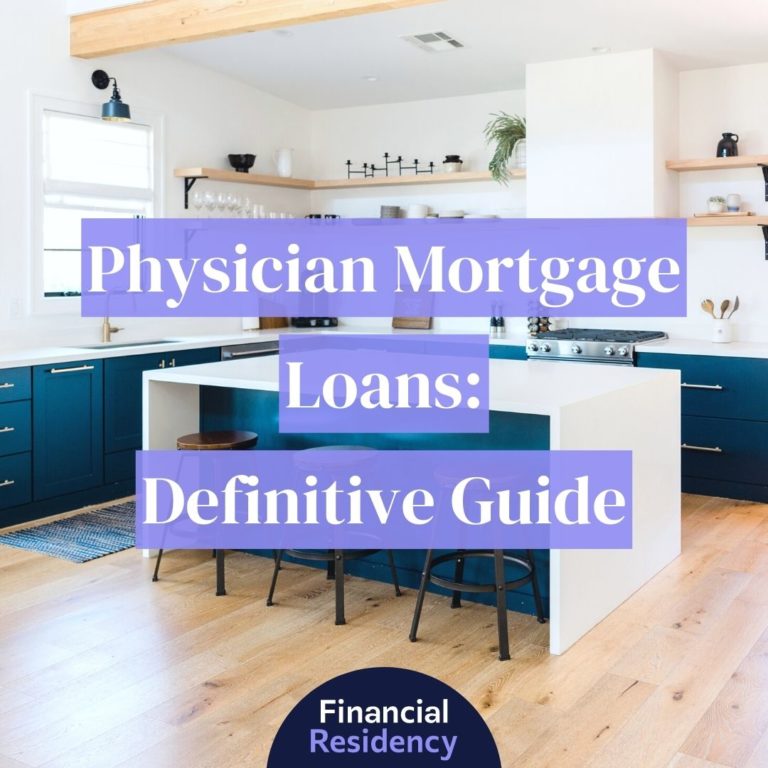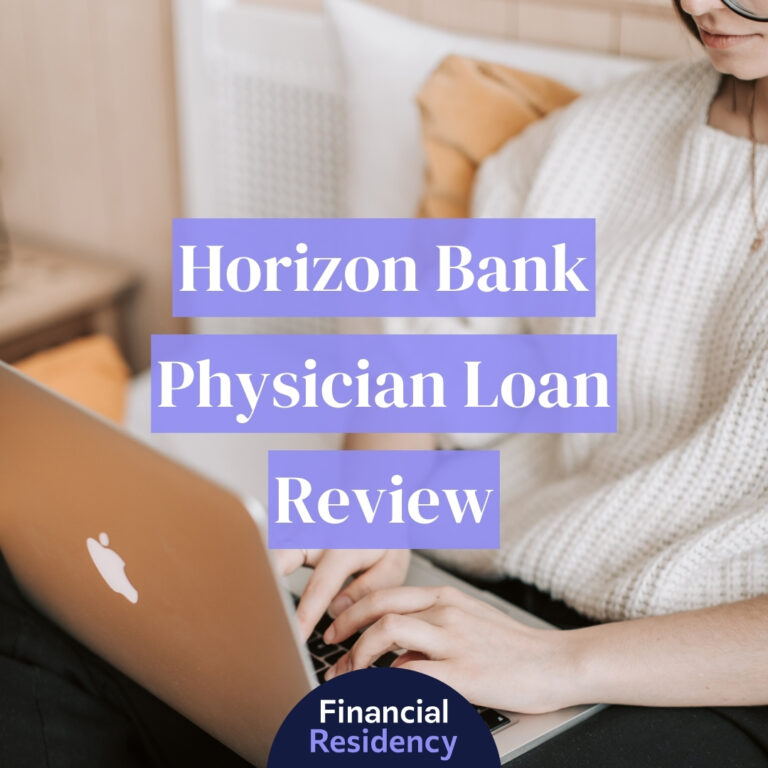Physicians work hard and deserve to buy the home of their dreams, but sometimes it’s impossible with high student loan debt and low starting income during internship, residency, and fellowship.
Physician loans help doctors get necessary financing by providing flexible underwriting guidelines, including low to no down payments.
Wells Fargo offers physicians options for mortgage financing, however, it’s technically a jumbo loan that allows higher loan amounts. Continue reading to find out how to apply and get a complete list of loan requirements.
About Wells Fargo
Wells Fargo is a well-known national bank providing various banking services, including physician mortgage loans. They’ve been in business for over 150 years and are a household name, operating nationwide and worldwide.
Wells Fargo is the country’s fourth largest bank, offering a wide selection of banking products to help physicians keep all their banking in one place. In addition, using their Private Banking services may make you eligible for other programs, including discounts on your jumbo, aka physician’s loan.
Wells Fargo Physician Loan Options
Wells Fargo’s physician loan option is a jumbo loan. It’s not just for physicians, but because of its higher loan limits, it works great for doctors buying expensive homes.
Jumbo loans exceed the conforming loan limit of $726,200, or $1,089,300, in high-cost areas.
Most lenders have strict guidelines for jumbo loans, but because they keep them on their books and no government agency guarantees them, there is room for flexibility.
Jumbo Loan Rates
Wells Fargo offers fixed and adjustable-rate options. Consider your choices carefully. A fixed rate may be a better option if you’re buying a home that you will keep for a long time. Then, you don’t have to worry about the rate changing and becoming unaffordable.
However, if this is a temporary purchase or you need a much lower rate now and can handle a higher rate down the road, an ARM may be a good option too.
Maximum Loan Amount
Wells Fargo considers the loan total maximums on a case-by-case basis. But, of course, the better your credit scores are, and the more money you put down, the more you can borrow.
Wells Fargo considers credit scores and debt-to-income ratios carefully. This sets this loan program apart from the typical physician loan program. However, the debt-to-income ratios aren’t quite as forgiving, especially regarding student loan debt.
If you have student loan debt, they may include the full payment in your DTI, even when you’re a resident or fellow and still working your way up the ladder. This may limit how much you can borrow.
Discounts
If you use Wells Fargo for your wealth management with their Private Banking Services, you may be eligible for an asset-based relationship discount on your physician loan. Wells Fargo isn’t transparent about the discount amount but rewards loyalty in high-net-worth individuals.
Private Mortgage Insurance
Wells Fargo jumbo loans often charge Private Mortgage Insurance if you can put down less than 20% on the home.
PMI is insurance that covers Wells Fargo if you stop making payments. It’s like a guarantee for them and is how they can approve loans with down payments of less than 20%. The good news is that most borrowers can eliminate PMI when they pay the loan balance below 80% of the home’s value.
Wells Fargo Physician Loan Requirements
Wells Fargo’s physician loan differs from most banks’ programs because it’s not only for physicians. Instead, it’s a jumbo loan program that approves loans higher than the Fannie Mae or Freddie Mac limits of $726,200.
Here’s what they look for in borrowers.
1. Credit Score Requirement
Like most banks, Wells Fargo requires great credit scores to qualify for jumbo financing. Typically, you’ll need a score of at least 700.
Like any loan, the higher your credit score is, the easier it is to qualify. In this case, the higher your credit score is, the more you can borrow. Wells Fargo wants to ensure you can pay your bills on time, which reflects a good credit score.
2. Down Payment Requirement
Wells Fargo requires high down payments on jumbo loans, usually 20% or higher. However, if you have excellent credit, you may qualify for a lower down payment but must pay Private Mortgage Insurance until you owe less than 80% of the home’s value.
The more money you put down on the home, the better the financial situation you create. A larger down payment is an investment in the home. You build equity faster and can refinance if you need to access your funds. Many physician loans with other lenders are also good for refinancing.
3. Cash Reserve Requirement
Wells Fargo doesn’t disclose how much you need in cash reserves to qualify for a jumbo loan. However, like most lenders, the more money you have saved, the less risk you pose, which increases your chance of approval.
Ideally, you should have six to twelve months of cash reserves available. This means six to twelve months of mortgage payments in a liquid account, such as a CD or high-yield savings account.
Wells Fargo wants reassurance that you can pay your loan even if there was a hiccup with your salary, which is what cash reserves do.
4. Income Verification Requirement
You must prove you have adequate income to qualify for a jumbo loan. This includes providing pay stubs to prove your current income, plus W-2s and tax returns to prove previous income to show stability and consistency.
Because Wells Fargo doesn’t have a designated physician’s loan, you must prove income, and usually, at least two years of it. This can make it harder for new physicians just out of school to use the program because they may not have the income history to qualify for the loan yet.
Unlike typical physician loans, you typically cannot qualify with an employment contract for a job you have yet to start.
How to Apply
Knowing what Wells Fargo expects when you apply for a Wells Fargo physician loan can help you increase your chances of approval.
Get Pre-Qualified
It’s always a good idea to get pre-qualified. While a pre-qualification is only an estimate of what you can afford, it gives you a good idea of where you stand and what your monthly payments will be.
To get pre-qualified, you’ll discuss your income, assets, and credit to determine if you meet the Wells Fargo qualifying requirements.
Getting pre-qualified doesn’t mean you’ll get the loan. But it gives you an idea of where you stand. Therefore, it’s important to be honest with your loan officer about your financial situation during this step to get accurate results.
Review Your Credit Report and Documentation
Your credit score is the first factor Wells Fargo will consider when you apply for a loan. So before applying, consider pulling your credit report to ensure it looks as good as possible.
Review the report for errors or issues you can fix, such as late payments or high credit card limits. The higher your credit score is, the easier it is to get approved for a Wells Fargo physician loan, so it’s worth the time and effort.
Aim for a credit score of 700+ for the best results.
You must also provide qualifying documentation to prove you can afford the loan. Before applying, it’s a good idea to gather the following documents:
- Paystubs covering the last 30 days
- W-2s for the last two years
- Tax returns for the last two years
- Two months of bank statements
- Employment contract
Gather all the paperwork that proves you have the money for as much of a down payment as you can make (20% recommended) and the closing costs, along with a stable income to cover the monthly payments.
Become Pre-Approved
After gathering the necessary paperwork and checking your credit, you can apply for your Wells Fargo physician loan.
You’ll complete a loan application and provide the above paperwork to prove you can afford the loan. You’ll also provide personal information, such as your Social Security number and birth date, and proof of your identity with your driver’s license or state ID.
An underwriter will review your documentation and determine if you’re eligible. The pre-approval pertains only to your personal qualifying factors and will be contingent on property approval when you find a home.
If they approve you personally for the loan, they’ll write a pre-approval letter. You can use this letter when placing offers on houses, as most sellers won’t accept an offer from a buyer unless they can prove they have financing.
Confirmation of Locked Rates
After finding a house and signing a sales contract, it’s important to lock your rates. You can’t close your loan without locking the rate, and it also provides peace of mind knowing you have the rate you can afford.
Wells Fargo offers different lock periods, so talk to your loan officer about how long to lock it, given your expected closing date.
Some lock periods have fees, so always ask about the cost of locking your rate before doing so.
Physician Loan Alternatives
Because Wells Fargo’s physician loan isn’t a true physician loan, you may also want to consider other options, including the following:
FHA Loans
FHA loans are government-backed loans to purchase a primary residence. They may work if the house you want to buy is for you to live in and is within the loan limits. Most areas have an FHA loan limit of $726,200, but there are low-cost and high-cost areas that change the limits from $472,030 to $1,089,300.
FHA loans require only a 3.5% down payment, but you’ll pay mortgage insurance as long as you have the loan. FHA loans also have more flexible underwriting requirements, including credit scores as low as 580 and debt-to-income ratios up to 50% because of the FHA guarantee.
However, FHA loans are only eligible for primary residences. Therefore, you cannot use them for a second or investment home, and your loan limits may be lower depending on the county you purchase a home in.
VA Loans
If you served in the military, you might be eligible for VA loans, which offer incredible benefits for doctors.
VA loans don’t require a down payment, no matter how much you borrow, including if the loan amount exceeds the conventional loan limits.
VA loans have the guarantee of the VA, so lenders can offer more flexible guidelines. For example, you may get approved for a VA loan with a 620+ credit score, no down payment, and a debt-to-income ratio as high as 43% – 50%. The key is proving you can afford the monthly payments.
The VA requires lenders to focus on a borrower’s disposable income or the money you have left after paying your bills. This allows them to put less emphasis on credit scores and debt-to-income ratios, knowing that they can afford the loan.
The best thing about VA loans is they don’t charge mortgage insurance. Borrowers pay an upfront but one-time funding fee; there isn’t monthly mortgage insurance.
A 20% Down Payment
If you only need to borrow less than the conventional loan limits ($726,200 in most areas) and have 20% to put down, you may qualify for a conventional loan. These Fannie Mae and Freddie Mac-backed loans offer competitive rates and terms, making financing easy.
However, these loans have stricter underwriting guidelines because no government agency guarantees them. You’ll likely need the following:
- 660+ credit score
- Maximum 36% debt-to-income ratio
- Stable employment and income for two years
- Proof of assets for the 20% down payment and closing costs
The nice thing is that with a 20% down payment, you don’t have to worry about Private Mortgage Insurance, keeping your mortgage payments more affordable.
Conventional Loans (With PMI)
If you don’t have a 20% down payment but can borrow less than $726,200, you may still qualify for a conventional loan. However, you may need a slightly higher credit score than if you had a 20% down payment.
The difference is you’ll pay Private Mortgage Insurance until you owe less than 80% of the home’s value.
The requirements are about the same, except for a higher credit score. However, some lenders may require lower debt-to-income ratios with a lower down payment. The key is providing as many good qualifying factors as possible to compensate for the lower down payment.
Refinancing a Current Loan
If you already own a house with equity, you may consider refinancing it to get cash out of it. You can then use the cash to purchase another house. You’ll likely still need financing on the house you purchase, but the larger down payment can make the loan more affordable.
Wells Fargo Physician Loan Alternatives
If you want a loan focused on physicians, here are seven alternatives.
1. Citizens Bank Physician Loans
Citizens Bank has a designated physician loan for those with an MD, DO, DDS, or DMD designation. You can borrow funds for a first or second home and need at least a 5% down payment.
If you’re still in your residency, you can borrow up to $600K, and attending physicians with at least one year of experience can borrow up to $3 million.
The downside is they are only available on the East coast in about ten states.
2. Cadence Bank Physician Loans
Cadence Bank offers 100% financing to eligible doctors on loans up to $1.5 million. Their doctor designations are broader than most banks, as they offer their loans to the following:
- MD
- DO
- OD
- NP
- DDS
- DVM
- PharmD
They offer fixed and adjustable-rate loans but are only available on primary residences.
3. UMB Bank Physician Loans
UMB Bank has a program called the Mortgage Portfolio Professional Loan Program. It’s available to the following doctors:
- DO
- MD
- DDS
- DMD
- OD
- PharmD
Doctors can get 100% financing on up to $1 million or put down 5% on loans up to $1.5 million and 10% on up to $2 million. However, you must be an attending physician to qualify for a 0% – 5% down payment.
UMB only offers loans as fixed-rate options, but they are available for purchase or refinance.
4. KeyBank Physician Loans
KeyBank offers a physician loan to doctors with any of the following designations:
- MD
- DO
- DPM
- DDS
- DMD
The program doesn’t apply to retired doctors. If you are eligible, you may borrow up to $3.5 million; however, if you borrow more than $1 million, you’ll need 10% to 15% down on the home.
KeyBank is a full-service lender, so they handle all underwriting and funding, making getting approved for a physician loan a little easier if you have unique circumstances.
The program is available on primary and secondary homes and on the following property types:
- Single-family homes
- Townhomes
- Condos
5. Flagstar Bank Physician Loans
Flagstar Bank offers a mortgage program they call the professional loan program. It’s open to residents, fellows, and physicians with the following designations:
- MD
- OD
- DPM
- DO
- NP
- PA
- DVM
- DDS
- DMD
The program is only available on your primary residence, and to get no down payment, you need a credit score of at least 720. If you have a lower credit score, you may qualify for a low down payment on loans up to $1.5 million.
The loan program is only for adjustable-rate mortgages, but no loan has PMI.
6. BMO Bank Physician Loans
BMO offers a physician loan program for residents, fellows, and newly appointed doctors. The loan program has flexible debt-to-income ratios to account for your student debt, and they don’t have an income history requirement. However, you must supply an employment contract with a future start date to qualify.
BMO lends up to 95% on up to $1.5 million and 90% on $2 million. No physician loans at BMO Bank require PMI.
7. Huntington Bank Physician Loans
Huntington Bank also provides a loan specifically for physicians. Their program is open to the following doctors:
- MD
- DO
- DMD
- DVM
- DDS
They offer up to 100% financing on up to $1 million, 95% on up to $1.25 million, and 90% on up to $2 million.
They require a minimum credit score of 700; however, you’ll need a higher score if you want to borrow over $1 million.
The program is available on primary homes only, for purchase or refinance, and all borrowers must have proof of income or an employment contract with a start date within the next couple of months. Some borrowers must also have cash reserves.
Find a Physician Loan in Your State
Pros and Cons
All mortgage loans have good and bad sides. Understanding them and weighing them in your decision is important.
Pros
- Some borrowers qualify for an asset-based relationship discount
- Available in fixed and adjustable rates
- There aren’t specific doctoral professions that qualify
Cons
- You will likely pay PMI
- They have strict debt-to-income ratios
- There’s no forgiveness for being a doctor with high student loans
Frequently Asked Questions
How much money can I take out with a Wells Fargo physician loan?
The Wells Fargo physician loan is a jumbo loan. The amount you can borrow depends on several factors including your debt-to-income ratio.
Are there interest rates on physician loans?
All mortgage loans charge interest; it’s how the lender can afford to lend money to so many borrowers. However, the interest rates on physician loans tend to be competitive, especially if you have good qualifying factors, such as a 700+ credit score or a low debt-to-income ratio.
What types of physicians qualify for Physician Home Loans?
Each lender has different requirements regarding which types of physicians qualify for a physician home loan. For example, some only lend to MDs and DOs, while others expand the offering to dentists, orthodontists, nurse practitioners, and pharmacists, among others.
Are Wells Fargo Physician Loans Right for You?
Since Wells Fargo doesn’t have a loan dedicated to physicians, it may be a good fit for already established doctors who just need a higher loan amount. However, consider looking elsewhere if you’re looking for a more forgiving loan for interns, fellows, or residents.





